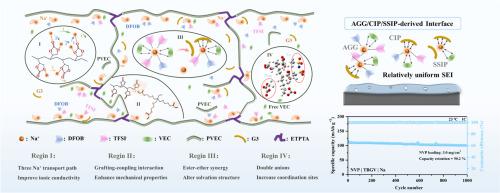调节凝胶聚合物电解质溶剂化结构的酯醚协同作用使钠金属电池稳定
IF 20.2
1区 材料科学
Q1 CHEMISTRY, PHYSICAL
引用次数: 0
摘要
凝胶聚合物电解质在钠金属电池的实际应用中遇到了诸如钠枝晶形成和界面不稳定性引起的循环稳定性差等挑战。本文提出了一种协同策略,重点关注由聚合物链设计和溶剂化调制调节的离子传输行为。以碳酸乙烯酯(VEC)为可聚合单体,以短链PVEC段为结构框架,通过ETPTA建立了三维交联网络。同时,通过战略性地利用VEC的低聚合度,其残留单体与G3共溶剂竞争性地调节溶剂化结构,从而优化传导机制和界面稳定性。此外,采用双盐策略(NaTFSI/NaDFOB)拓宽电化学窗口,提高离子电导率。优化后的TBGV电解质具有1.8 mS/cm的高离子电导率和优异的循环性能。组装的Na||Na对称电池在0.1 mA/cm²下可稳定循环9000 h,而NVP||Na全电池具有良好的循环稳定性和倍率能力,在1℃下可保持111.8 mAh/g的放电容量,1000次循环后容量保持率为90.2%。本文章由计算机程序翻译,如有差异,请以英文原文为准。

Ester-ether synergistic interactions regulating the solvation structure of gel polymer electrolytes enable stable sodium metal batteries
Gel polymer electrolytes encounter challenges such as sodium dendrite formation and poor cycling stability caused by interfacial instability in practical sodium metal battery applications. Herein, a synergistic strategy focusing on ion transport behavior regulated by polymer chain design and solvation modulation is proposed. Using vinyl ethylene carbonate (VEC) as a polymerizable monomer, we establish a 3D crosslinked network via ETPTA with short-chain PVEC segments as the structural framework. Concurrently, by strategically leveraging the low polymerization degree of VEC, its residual monomers competitively modulate solvation structures with the G3 co-solvent, thereby optimizing ion conduction mechanisms and interfacial stability. Furthermore, a dual-salt strategy (NaTFSI/NaDFOB) is employed to broaden the electrochemical window and improve ionic conductivity. The optimized TBGV electrolyte achieves a high ionic conductivity of 1.8 mS/cm and exceptional cycling performance. The assembled Na||Na symmetric cell demonstrates stable cycling for 9000 h at 0.1 mA/cm², and the NVP||Na full cell exhibits excellent cycling stability and rate capability, which maintains 111.8 mAh/g discharge capacity at 1 C with 90.2 % capacity retention after 1000 cycles.
求助全文
通过发布文献求助,成功后即可免费获取论文全文。
去求助
来源期刊

Energy Storage Materials
Materials Science-General Materials Science
CiteScore
33.00
自引率
5.90%
发文量
652
审稿时长
27 days
期刊介绍:
Energy Storage Materials is a global interdisciplinary journal dedicated to sharing scientific and technological advancements in materials and devices for advanced energy storage and related energy conversion, such as in metal-O2 batteries. The journal features comprehensive research articles, including full papers and short communications, as well as authoritative feature articles and reviews by leading experts in the field.
Energy Storage Materials covers a wide range of topics, including the synthesis, fabrication, structure, properties, performance, and technological applications of energy storage materials. Additionally, the journal explores strategies, policies, and developments in the field of energy storage materials and devices for sustainable energy.
Published papers are selected based on their scientific and technological significance, their ability to provide valuable new knowledge, and their relevance to the international research community.
 求助内容:
求助内容: 应助结果提醒方式:
应助结果提醒方式:


